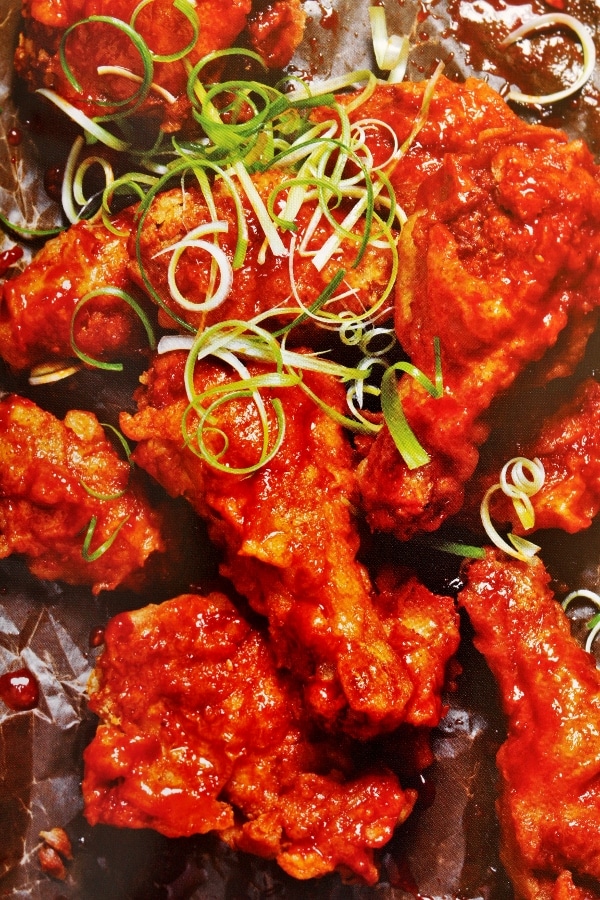
Yang states that despite the spicy flavor, the very first yangnyeom-chikin did not include gochujang as one of their marinating ingredients. Yun decided to pull a twist on the traditional fried chicken to soften the hard shells of the chicken, and appease more Korean customers by marinating it sweet and spicy. He noticed that customers in his restaurant were struggling to chew on the hard, crisp layers of the fried chicken, and led to inconveniences such as scraped palates. The well-known variety with spicy coatings, also known as yangnyeom-chikin, had its history begin in 1982 by Yun Jonggye, who was running a fried chicken restaurant (later Mexican Chicken ) at Daegu. It was "embraced as an excellent food pairing for draft beer" the word for the pairing, " chimaek", is a portmanteau of "chicken" and "maekju", the Korean word for beer. He started his business in Korea with six pieces of fried chicken between ₩280 to ₩330, and sold around 900 pieces as his beginning career. He began frying chicken there, and received accolades for creating ' ginseng chicken'. Yu stated that his idea of selling smaller, individual pieces of fried chicken in Korea came along in 1975 when he went to go study abroad in the United States. The first modern Korean fried chicken franchise, Lims Chicken, was established in 1977 in the basement of Shinsegae Department Store, Chungmu-ro, Seoul by Yu Seok-ho.
/cdn.vox-cdn.com/uploads/chorus_image/image/56880273/shutterstock_635846627.0.jpg)
It was not until the 1970s when cooking oil was widely available that the modern fried chicken started appearing in Korea. The trend of eating chicken began in Korea during the late 1960s, when Myeongdong Yeongyang Center in Seoul began selling whole chicken roasted over an electric oven.

Fried chicken was cooked and served with a special seasoning made of vinegar and soy sauce under the name of "Pogye" (포계) in early Joseon dynasty. The recipe for frying chicken was already a form of cooking in the 15th century, so it is presumed that it has been cooked since the Goryeo Dynasty. The National Institute of Korean Language does not recognize huraideu-chikin as the conventional name, but insists on the transliteration (and transvocalization) peuraideu-chikin, which it also insists should be " refined" to dakgogi-twigim ( 닭고기 튀김, "chicken meat fritter"). This is often used to differentiate it from yangnyeom-chikin ( 양념 치킨, "seasoned chicken"). (The Japanese forced occupation only ended in 1945.) The phrase huraideu-chikin is often shortened to huraideu ( 후라이드) and refers to a fried chicken dish without the added seasonings post-frying. The more commonly used form, huraideu-chikin ( 후라이드 치킨), may have been adopted in Korean owing to residual influence from the Japanese convention that persisted in Korea in the 1970s. The unshortened form peuraideu chikin, despite being the "correct" transliteration, is not as popular in Korea.

Both chikin and tongdak are occasionally referred to as dak-twigim ( 닭튀김, "chicken fritter"). Fried chicken that is not chopped before frying is called tongdak ( 통닭, "whole chicken").

According to the National Institute of Korean Language, the word chikin ( 치킨) refers to "a dish made by coating chopped chicken with flour, and frying or baking it". The word is shortened from peuraideu chikin ( 프라이드 치킨), which is a transliteration of the English phrase "fried chicken". The Korean word chikin ( 치킨) refers to fried chicken (and occasionally also to roasted chicken), while the name for the domesticated fowl is dak ( 닭). Pickled radishes and beer (or carbonated drink) are often served with Korean fried chicken. After frying, the chicken is usually hand-painted with sauce using a brush in order to evenly coat the chicken with a thin layer. Korean fried chicken restaurants commonly use small- or medium-sized chickens these younger chickens result in more tender meat. The chicken is usually seasoned with spices, sugar, and salt, prior to and after being fried. Korean fried chicken was described by Julia Moskin of The New York Times as a "thin, crackly and almost transparent crust". In South Korea, fried chicken is consumed as a meal, an appetizer, anju (food that is served and eaten with drinks), or as an after-meal snack. Korean fried chicken, usually called chikin ( 치킨, from the English "chicken") in Korea, refers to a variety of fried chicken dishes created in South Korea, including the basic huraideu-chicken ( 후라이드 치킨, from the English "fried chicken") and spicy yangnyeom chicken ( 양념 치킨, "seasoned chicken").


 0 kommentar(er)
0 kommentar(er)
